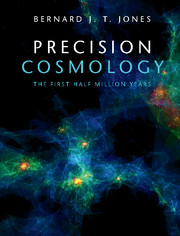Book contents
- Frontmatter
- Dedication
- Contents
- Preface
- Notation and Conventions
- Part I 100 Years of Cosmology
- Part II Newtonian Cosmology
- Part III Relativistic Cosmology
- Part IV The Physics of Matter and Radiation
- Part V Precision Tools for Precision Cosmology
- Appendix A SI, CGS and Planck Units
- Appendix B Magnitudes and Distances
- Appendix C Representing Vectors and Tensors
- Appendix D The Electromagnetic Field
- Appendix E Statistical Distributions
- Appendix F Functions on a Sphere
- Appendix G Acknowledgements
- References
- Index
Appendix A - SI, CGS and Planck Units
Published online by Cambridge University Press: 04 May 2017
- Frontmatter
- Dedication
- Contents
- Preface
- Notation and Conventions
- Part I 100 Years of Cosmology
- Part II Newtonian Cosmology
- Part III Relativistic Cosmology
- Part IV The Physics of Matter and Radiation
- Part V Precision Tools for Precision Cosmology
- Appendix A SI, CGS and Planck Units
- Appendix B Magnitudes and Distances
- Appendix C Representing Vectors and Tensors
- Appendix D The Electromagnetic Field
- Appendix E Statistical Distributions
- Appendix F Functions on a Sphere
- Appendix G Acknowledgements
- References
- Index
Summary
Systems of units are always a problem, despite international agreement to standardise on the SI system. The old cgs system and its multitude of mutually inconsistent variants (Gauss, Lorentz–Heaviside, esu, emu, etc.) is still in use. This is particularly an issue when it comes to using the Maxwell equations. In astrophysics we generally see a mixture of cgs units and subject-specific units, like the magnitude scale for brightness, parsecs for distance, and flux units in the older radio astronomy literature. This is what we might call the Astrophysical System of Units and, like many contemporary authors, I have adhered to that in this text. However, certain issues must be clarified, and in particular the conventions used in the Maxwell equations.
This appendix provides translation between Gaussian cgs units and the SI system for several of the quantities that are used in the text, and provides some update on the values of the fundamental physical constants that have occurred since the decision to fix the speed of light at a given numerical value. The Maxwell equations have a small section to themselves.
SI, MKS and cgs
There has been a slow move in astronomy away from the traditional centimetre-gram-second (CGS) based system of units that evolved in the 19th century towards the metric metre-kilogram-second (MKS) based system of units and the subsequent International System (SI), which is also known as the MKSA system. However, the change has been slow or, as in the case of astronomy, only partial. By the 1950s many fields had adopted their own subject-specific units, chosen largely because they were particularly convenient or simply entrenched in the culture of the discipline. There are perhaps just two reasons for the slowness of this change: teachers today were often taught in cgs or hybrid systems, and used textbooks with which they were familiar. Moving from cgs to SI units takes people out of their comfort zone.
The full details of the system of physical units are maintained and documented by the National Institute of Standards and Technology, NIST, which is maintained by the US
Department of Commerce. The information presented here is for convenience and is largely abstracted from the NIST web site.
- Type
- Chapter
- Information
- Precision CosmologyThe First Half Million Years, pp. 673 - 678Publisher: Cambridge University PressPrint publication year: 2017



